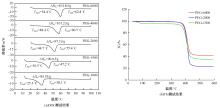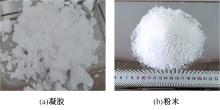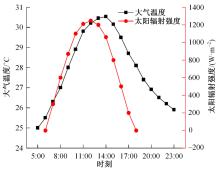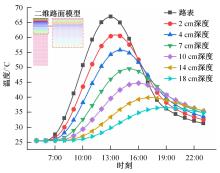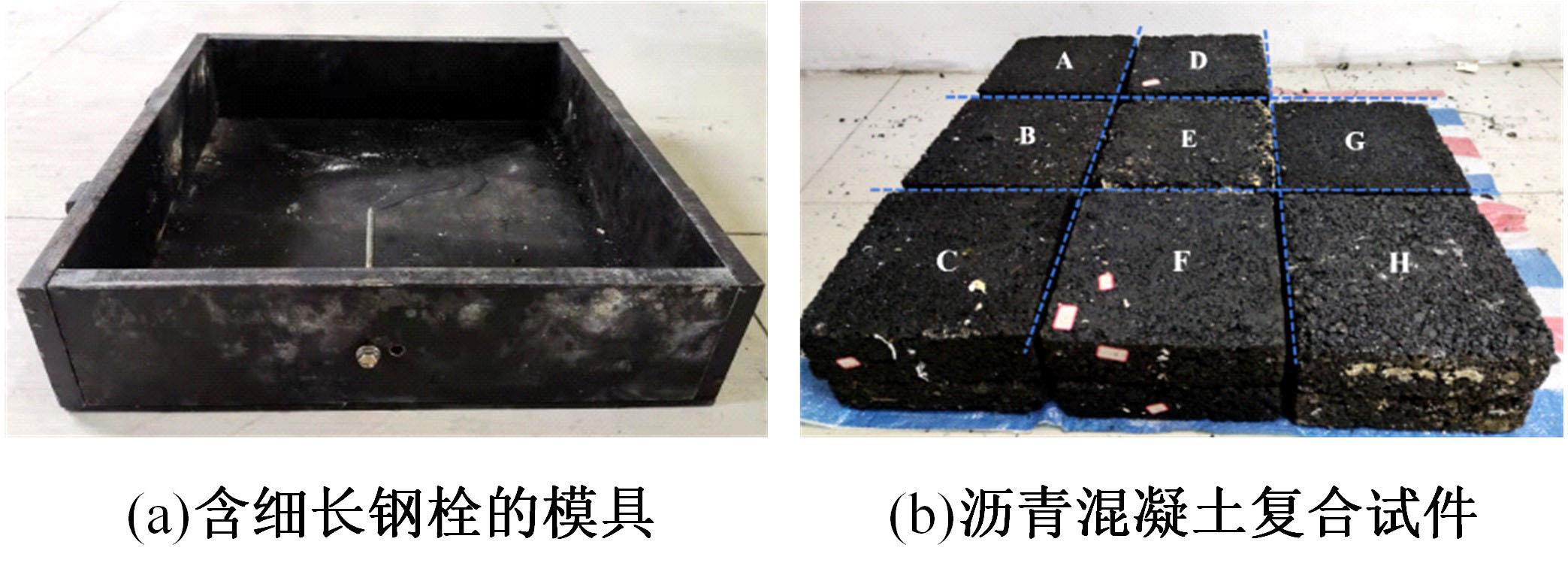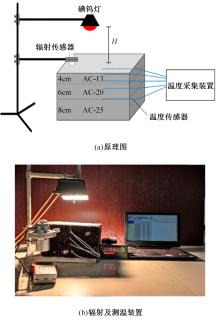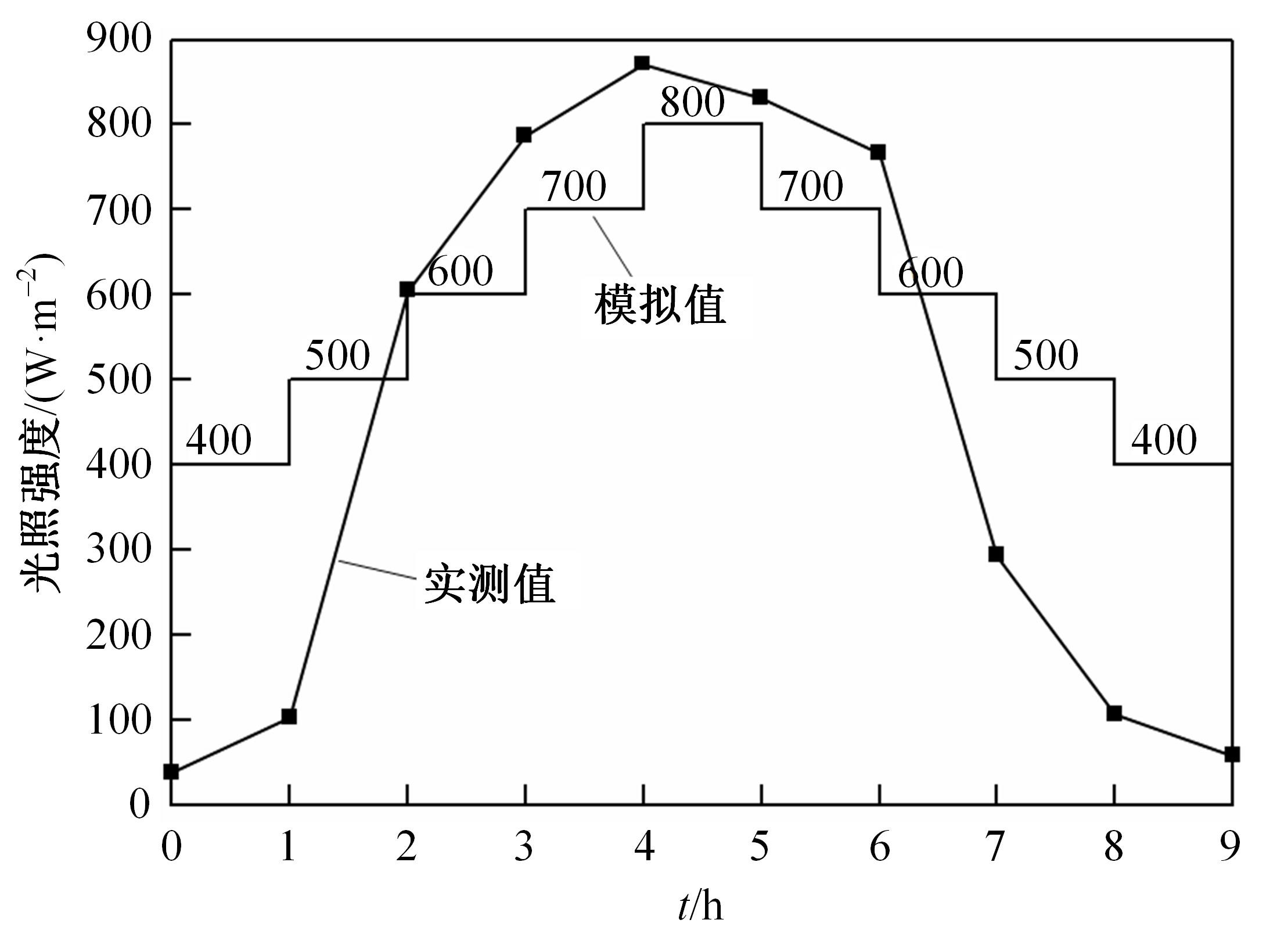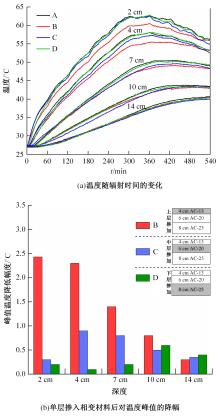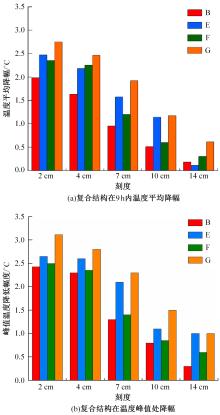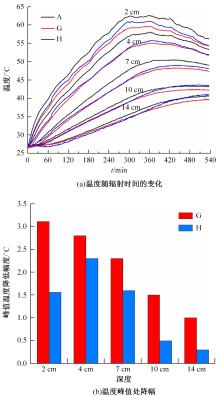Journal of Jilin University(Engineering and Technology Edition) ›› 2024, Vol. 54 ›› Issue (1): 180-187.doi: 10.13229/j.cnki.jdxbgxb.20220232
Laboratory investigation on cooling effect of multi-layer phase change asphalt concrete
Jun CHEN1( ),Zhen-hao SUN1,Cheng ZHAO1,Xin-yi WU2,Jun-peng WANG1
),Zhen-hao SUN1,Cheng ZHAO1,Xin-yi WU2,Jun-peng WANG1
- 1.College of Civil and Transportation Engineering,Hohai University,Nanjing 210098,China
2.School of Energy and Environment,Southeast University,Nanjing 211189,China
CLC Number:
- U414
| 1 | Badin G, Ahmad N, Ali H M. Experimental investigation into the thermal augmentation of pigmented asphalt[J]. Physica A: Statistical Mechanics and its Applications, 2019: No.123974. |
| 2 | Babagoli R, Ziaiari H. Evaluation of rutting performance of stone matrix asphalt mixtures containing warm mix additives[J]. Journal of Central South University, 2017, 24(2):360-373. |
| 3 | Kaphle R. Improving the thermal properties of asphalt concrete to reduce urban heat island effects[D]. San Antonio: The University of Texas,2018. |
| 4 | Sen S, Roesler J. Thermal and optical characterization of asphalt field cores for microscale urban heat island analysis[J]. Construction and Building Materials, 2019, 217(30):600-611. |
| 5 | Shi X, Rew Y, Ibers E, et al. Effects of thermally modified asphalt concrete on pavement temperature, International Journal of Pavement Engineering, 2019, 20(6): 669-681. |
| 6 | Hai V V, Park D W, Seo W J, et al. Evaluation of asphalt mixture modified with graphite and carbon fibers for winter adaptation: thermal conductivity improvement[J]. Journal of materials in civil engineering, 2017, 29(1):No.04016176. |
| 7 | Chen J, Zhou Z, Wu J, et al. Field and laboratory measurement of albedo and heat transfer for pavement materials[J]. Construction and Building Materials, 2019, 202:46-57. |
| 8 | 姬彪.沥青路面热反射涂层的研究与发展[J].科技创新与应用,2017(16):229. |
| Ji Biao. Research and development of thermal reflective coating for asphalt pavement[J]. Technology Innovation and Application, 2017(16): 229. | |
| 9 | 孙斌祥,黄尹泰,沈航,等.沥青路面热反射涂层的降温性能研究综述[J].科学技术与工程,2021,21(9):3446-3456. |
| Sun Bin-xiang, Huang Yin-tai, Shen Hang, et al. Overview of studies on cooling performance of thermal reflection coating on asphalt pavement[J]. Science Technology and Engineering, 2021, 21(9): 3446-3456. | |
| 10 | 沙爱民,蒋玮.环保型多孔路面材料设计理念与架构[J].中国公路学报,2018,31(9):1-6. |
| Sha Ai-min, Jiang Wei. Design philosophy and architecture of eco-friendly porous pavement materials[J]. China Journal of Highway and Transport, 2018,31(9): 1-6. | |
| 11 | 张睿.保水路面蒸发降温模型与实验研究[D]. 北京:中国地质大学,2019. |
| Zhang Rui. Modeling and experimental studies on the evaporative cooling of water-retaining pavements[D]. Beijing: China University of Geosciences, 2019. | |
| 12 | 于华洋,马涛,王大为,等.中国路面工程学术研究综述·2020[J].中国公路学报,2020,33(10):1-66. |
| Yu Hua-yang, Ma Tao, Wang Da-wei, et al. Review on China’s pavement engineering research·2020[J]. China Journal of Highway and Transport, 2020,33(10): 1-66. | |
| 13 | 刘涛,郭乃胜,谭忆秋,等. 路用相变材料研究现状和发展趋势[J].材料导报,2020,34(23):23179-23189. |
| Liu Tao, Guo Nai-sheng, Tan Yi-qiu, et al. Research and development trend of road usage phase change materials[J]. Materials Reports, 2020,34(23): 23179-23189. | |
| 14 | 李文虎,何丽红,朱洪洲,等.PEG/SiO2相变颗粒对沥青混合料储热及高温性能的影响[J]. 公路交通科技,2015,32(4):16-20. |
| Li Wen-hu, He Li-hong, Zhu Hong-zhou, et al. Effect of PEG/SiO2 phase change particles on heat storage and high temperature performance of asphalt mixture[J]. Journal of Highway and Transportation Research and Development, 2015,32(4): 16-20. | |
| 15 | 雷宝财,范贤鹏,郑木莲. PEG/SiO2型控温相变沥青混合料的性能[J].筑路机械与施工机械化,2020,37():6-9. |
| Lei Bao-cai, Fan Xian-peng, Zheng Mu-lian. Performance of asphalt mixture with temperature-controlling phase change material of PEG/SiO2 [J]. Road Machinery and Construction Mechanization, 2020,37(Sup.1): 6-9. | |
| 16 | Kuai C, Chen J, Shi X, et al. Regulating porous asphalt concrete temperature using PEG/SiO2 phase change composite: experiment and simulation[J]. Construction and Building Materials, 2020, 273(3):No.122043. |
| 17 | Chen J, Li J, Wang H, et al. Preparation and effectiveness of composite phase change material for performance improvement of open graded friction course[J]. Journal of Cleaner Production, 2019, 214: 259-269. |
| 18 | Chen J, Zhang W, Shi X, et al. Use of PEG/SiO2 phase change composite to control porous asphalt concrete temperature[J]. Construction and Building Materials, 2020, 245:No.111845. |
| 19 | 李伊,刘黎萍,孙立军.全厚式沥青路面温度场预估模型[J].同济大学学报:自然科学版,2020,48(3):377-382. |
| Li Yi, Liu Li-ping, Sun Li-jun. Temperature field prediction model for thick asphalt layer[J]. Journal of Tongji University(Natural Science), 2020,48(3): 377-382. | |
| 20 | 张东.沥青路面控温用定形相变材料的制备与性能研究[D]. 武汉:武汉理工大学材料科学与工程学院,2019. |
| Zhang Dong. Research on preparation and performance of shape-formed phase change materials for asphalt pavement temperature-control[D]. Wuhan: School of Materials Science and Engineering,Wuhan University of Technology, 2019. | |
| 21 | 刘大龙,马岚,赵辉辉.城市复杂辐射场形成机理[J].太阳能学报,2021,42(10):458-463. |
| Liu Da-long, Ma Lan, Zhao Hui-hui. Formation mechanism of urban complex radiation field[J]. Acta Energiae Solaris Sinica, 2021,42(10): 458-463. |
| [1] | Zhuang WANG,Zhen-gang FENG,Dong-dong YAO,Qi CUI,Ruo-ting SHEN,Xin-jun LI. Research progress of conductive asphalt concrete [J]. Journal of Jilin University(Engineering and Technology Edition), 2024, 54(1): 1-21. |
| [2] | Sheng-qian ZHAO,Zhuo-hong CONG,Qing-long YOU,Yuan LI. Adhesion and raveling property between asphalt and aggregate: a review [J]. Journal of Jilin University(Engineering and Technology Edition), 2023, 53(9): 2437-2464. |
| [3] | Tao MA,Yuan MA,Xiao-ming HUANG. Optimal combination of key parameters of intelligent compaction based on multiple nonlinear regression [J]. Journal of Jilin University(Engineering and Technology Edition), 2023, 53(7): 2067-2077. |
| [4] | Liu YANG,Chuang-ye WANG,Meng-yan WANG,Yang CHENG. Traffic flow characteristics of six⁃lane freeways with a dedicated lane for automatic cars [J]. Journal of Jilin University(Engineering and Technology Edition), 2023, 53(7): 2043-2052. |
| [5] | Zheng-feng ZHOU,Xiao-tao YU,Ya-le TAO,Mao ZHENG,Chuan-qi YAN. High-temperature performance evaluation of resin and elastomer high viscosity asphalt based on grey correlation analysis [J]. Journal of Jilin University(Engineering and Technology Edition), 2023, 53(7): 2078-2088. |
| [6] | Qing-xia ZHANG,Ji-lin HOU,Xin-hao AN,Xiao-yang HU,Zhong-dong DUAN. Road roughness identification method based on vehicle impulse response [J]. Journal of Jilin University(Engineering and Technology Edition), 2023, 53(6): 1765-1772. |
| [7] | Ping JIANG,Ye-wen CHEN,Xian-hua CHEN,Wei-qing ZHANG,Na LI,Wei WANG. Unconfined compression behavior of modified lime stabilized soil under dry wet and freeze⁃thaw cycles [J]. Journal of Jilin University(Engineering and Technology Edition), 2023, 53(6): 1809-1818. |
| [8] | Chun-di SI,Ya-ning CUI,Zhong-yin XU,Tao-tao FAN. Meso⁃mechanical behavior analysis of asphalt bridge deck pavement after interlayer bonding failure [J]. Journal of Jilin University(Engineering and Technology Edition), 2023, 53(6): 1719-1728. |
| [9] | Yan LI,Jiu-peng ZHANG,Zi-xuan CHEN,Guo-jing HUANG,Pei WANG. Evaluation of asphalt pavement performance based on PCA⁃PSO⁃SVM [J]. Journal of Jilin University(Engineering and Technology Edition), 2023, 53(6): 1729-1735. |
| [10] | Zhuang-zhuang LIU,Wen-qing ZHENG,Jian ZHENG,Yi-zheng LI,Peng-yu JI,Ai-min SHA. Pavement surface temperature monitoring method based on gridding approach [J]. Journal of Jilin University(Engineering and Technology Edition), 2023, 53(6): 1746-1755. |
| [11] | Xiao-kang ZHAO,Zhe HU,Jiu-peng ZHANG,Jian-zhong PEI,Ning SHI. Research progress in intelligent monitoring of pavement icing based on optical fiber sensing technology [J]. Journal of Jilin University(Engineering and Technology Edition), 2023, 53(6): 1566-1579. |
| [12] | Bing HUI,Xin-yi YANG,Le-yang ZHANG,Yang LI. Influence of detecting track offset on calculation error of asphalt pavement wearing [J]. Journal of Jilin University(Engineering and Technology Edition), 2023, 53(6): 1756-1764. |
| [13] | Jue LI,An-shun ZHANG,Jun-hui ZHANG,Jun-feng QIAN. Model testing and numerical analysis of dynamic response of graded crushed rock base structure [J]. Journal of Jilin University(Engineering and Technology Edition), 2023, 53(6): 1782-1789. |
| [14] | Bo LI,Xin LI,Hong RUI,Yuan LIANG. Displacement prediction of tunnel entrance slope based on variational modal decomposition and grey wolf optimized extreme learning machine [J]. Journal of Jilin University(Engineering and Technology Edition), 2023, 53(6): 1853-1860. |
| [15] | Ning WANG,Tao MA,Feng CHEN,Yong-qiang FU. Key factors affecting smart aggregate perception and data analysis methods [J]. Journal of Jilin University(Engineering and Technology Edition), 2023, 53(6): 1799-1808. |
|
||
